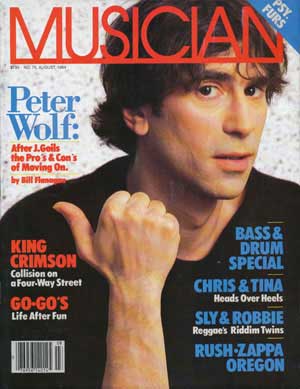Bookends: Rush's Neil Peart And Geddy Lee
By Freff, Musician, August 1984, transcribed by pwrwindows

What's the Role of the Rhythm section in Rush?
Peart: A rhythm section is an indefinable thing. I don't put it down to the bassist and the drummer alone being the rhythm section, really; nowadays, it's the whole band, even the vocalist. I hate to get that...provincial about it. There's a kind of "us and them" attitude, bassists and drummers against the rest of the band. I grew up like that, taking it all in. But I reject it now. It was and is wrong, from both sides.
A rhythm section is fundamentally a pulse, a foundation for the rest of the music to be built upon. A rhythm is set up that is interesting and somehow hypnotic, and then the musical changes are allowed to interweave in a natural way on top of that, related to it but not dependent upon it. With Rush, being a trio puts a lot of weight on everybody in that respect. The guitar and drums have to interact rhythmically as much as the bass and drums do, to really start to stretch the limitation of the form. The Police are a good illustration of that.
Over ten years, we've taken a lot of different approaches to using rhythm, experimenting with complicated time signatures and such because we found it exciting. For a time, we threw out the pulse as being a fundamental necessity, which was good for Rush because we needed to throw out all the rules and look around to see what we were capable of doing. But now we've come around full circle to the point where that common pulse is important again. Our songs still change time signatures a lot, but always around a central pulse.
Lee: I feel it's very important for the urgency, and sometimes the anger of the sound, to come from the rhythm section. What Neil and I try and do is create a solid bed, be it funky or up tempo or laid-back, so that Alex's guitar can be looser on top of us. That changes when I'm playing keyboards: there's a real open area for the drums to loosen up. You can feel the cruise - the bass is gone and the bottom end, while still deep, is no longer as demanding. The bass isn't punching at you, and it allows you to focus in on the ride cymbal and the little things that make a song move.
Of course, in contemporary rock the role of the rhythm section is changing because so many records are being made with artificial rhythm sections. And so much is textural. In a lot of new English music there's this huge snare sound that is the only common denominator. There's no real tom-toms, no real hyperactive bass, and off and on at whim there'll be lots of Latino-style percussion because there's so much air for them, so much space, since there's only a snare and a synthesized bass drum holding it all together.
Inspiration and Influences
Peart: I would say people like Peter Gabriel, Talking Heads, Japan, Roxy Music. Jamaican music, of course, African music - I like King Sunny Ade a lot...on the modern English pop music front there's Ultravox, the Police, Culture Club, and on the jazz-fusion front there's always been Brand X and Weather Report. Actually, my influences go far beyond what I really like. I learn from a lot of things, whether or not they appeal to me emotionally.
Lee: I've always been a big fan of the Chris Squire/Alan White and Chris Squire/Bill Bruford combinations in Yes. They were probably my biggest early influences. Then Jeff Berlin and Bill Bruford when they were playing together, and Tony Levin and Jerry Marotta.
Best Work Together
Peart: I guess I'll be obvious and say our most recent album. But again, I don't limit it just to myself and Geddy. Because often when he's playing keyboards I have to interact together with our guitarist, Alex Lifeson, in the way that a rhythm section would. That's something that we explored a lot on Signals, our previous album.
Current Equipment
Peart: I'm using a custom prototype Tama set, with thinner walls than their conventional shells. That makes them more resonant. It went out of fashion for a while to have drums that actually sang. They were all supposed to be very dull and ultimately controllable by the electronics of the day. But things have progressed to the point where technology had better learn how to handle the natural sound of drums. Anything else is like throwing a blanket inside a grand piano to make it easier to record. For the rest I've always used Avedis Zildjian cymbals, various drumheads depending on the drum and the sound I want to achieve, and ProMark sticks.
Lee: I'm using a Steinberger L2 bass on the current tour, but for recording I also use a Fender Jazz bass and a Rickenbacker. For amplification I've got a Furman Parametric Equalizer, which I actually use as a pre-amp, API 550A equalizers, BGW power amps, and speaker cabinets loaded with 15-inch Electro-Voice speakers. For strings I like the Rotosound satin-finish set that are specially designed for the Steinberger. As for keyboards, my main one this tour is a PPG Wave 2.2 - I used that all over the album. I'm also playing a Roland JP-8, an Oberheim OBX-a, a Minimoog, and Moog Taurus pedals. The Oberheim has been specially interfaced so I can run it from the pedals.